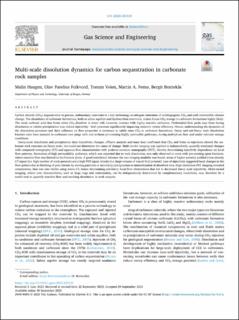| dc.contributor.author | Haugen, Malin | |
| dc.contributor.author | Folkvord, Olav Parelius | |
| dc.contributor.author | Veien, Torunn | |
| dc.contributor.author | Fernø, Martin | |
| dc.contributor.author | Brattekås, Bergit | |
| dc.date.accessioned | 2024-01-17T12:18:48Z | |
| dc.date.available | 2024-01-17T12:18:48Z | |
| dc.date.created | 2023-10-02T09:02:39Z | |
| dc.date.issued | 2023 | |
| dc.identifier.issn | 1875-5100 | |
| dc.identifier.uri | https://hdl.handle.net/11250/3112159 | |
| dc.description.abstract | Carbon dioxide (CO2) sequestration in porous, sedimentary reservoirs is a key technology to mitigate emissions of anthropogenic CO2 and curb irreversible climate change. The abundance of carbonate formations, both as saline aquifers and hydrocarbon reservoirs, makes future CO2 storage in carbonate formations highly likely. The weak carbonic acid that forms when CO2 dissolves in water will, however, interact with highly reactive carbonate. Preferential flow paths may form during dissolution or calcite precipitation may reduce injectivity - both processes significantly impacting reservoir sweep efficiency. Hence, understanding the dynamics of the dissolution processes and their influence on flow properties is necessary to safely store CO2 in carbonate formations. Darcy and sub-Darcy scale dissolution kinetics were here assessed in carbonate core plugs with and without pre-existing highly permeable pathways, during multiphase flow and under relevant storage conditions.
Darcy-scale dissolution and precipitation data (injectivity changes, effluent analysis and mass loss) confirmed that CO2 and brine co-injections altered the carbonate rock structure on Darcy scale, but could not determine the cause of change. Multi-modal imaging was applied to independently quantify structural changes with computed tomography (CT) and aqueous flow characteristics with positron emission tomography (PET), thereby determining injectivity dependence on local flow patterns. Formation of high permeability pathways, which was expected due to rock dissolution, was only observed in cores with pre-existing open fractures, where reactive flow was limited to the fracture plane. A good correlation between the two imaging modules was found: areas of higher porosity yielded a low-density CT signal (i.e. high number of voids present) and a high PET signal density (i.e. large volume of traced fluid present). Loss of injectivity suggested local changes in the flow pattern due to blocking of pore throats by moving particles or secondary precipitation or mineralization of dissolved ions. High-resolution PET imaging revealed cementation, that was also visible using micro-CT, hence determining sub-Darcy local flow obstructions that led to decreased Darcy scale injectivity. Multi-modal imaging, where core characteristics, such as large vugs and cementation, can be independently determined by complementary modalities, may therefore be a useful tool to quantify reactive flow and resulting dissolution in rock samples. | en_US |
| dc.language.iso | eng | en_US |
| dc.publisher | Elsevier | en_US |
| dc.rights | Navngivelse 4.0 Internasjonal | * |
| dc.rights.uri | http://creativecommons.org/licenses/by/4.0/deed.no | * |
| dc.title | Multi-scale dissolution dynamics for carbon sequestration in carbonate rock samples | en_US |
| dc.type | Journal article | en_US |
| dc.type | Peer reviewed | en_US |
| dc.description.version | publishedVersion | en_US |
| dc.rights.holder | Copyright 2023 The Author(s) | en_US |
| dc.source.articlenumber | 205139 | en_US |
| cristin.ispublished | true | |
| cristin.fulltext | original | |
| cristin.qualitycode | 1 | |
| dc.identifier.doi | 10.1016/j.jgsce.2023.205139 | |
| dc.identifier.cristin | 2180780 | |
| dc.source.journal | Journal of Natural Gas Science and Engineering | en_US |
| dc.relation.project | Norges forskningsråd: 324818 | en_US |
| dc.relation.project | Norges forskningsråd: 280341 | en_US |
| dc.relation.project | Norges forskningsråd: 331841 | en_US |
| dc.identifier.citation | Journal of Natural Gas Science and Engineering. 2023, 119 (Part A), 205139. | en_US |
| dc.source.volume | 119 | en_US |
| dc.source.issue | Part A | en_US |

